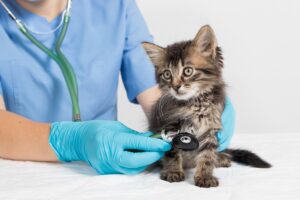
Mount Carmel Animal Hospital informs readers and pet owners about feline lower urinary tract disease (FLUTD).
Is your kitty having urination problems? Is he or she urinating in inappropriate areas of your home? If so, your pet might have lower urinary tract disease. Mount Carmel Animal Hospital informs readers and pet owners about feline lower urinary tract disease (FLUTD).
What is It?
Feline lower urinary tract disease covers a multitude of disorders, from mild to serious. FLUTD can be overwhelming for pet owners and vets because the underlying cause can be hard to identify, and the illness can vary in severity.
Causes of FLUTD
Common causes of FLUTD include idiopathic cystitis (a painful bladder condition), urolithiasis (solid materials in the urinary tract), and urethral obstruction (a blockage of the urinary tract):
Idiopathic Cystitis (FIC)
FIC is commonly diagnosed in cats with FLUTD. These cats make frequent attempts to pee and often have blood in their urine. Stress can be a major factor in the development of idiopathic cystitis. Possible sources of stress include environmental changes, changes in food schedules, and changes in the number of animals in a household.
Urinary Stones
Urinary stones are another potential source of FLUTD. These rock-hard collections of minerals develop in cats’ urinary tracts and even obstruct the urinary bladder. The treatment of a feline with urinary stones varies depending on the mineral composition of the stones, but surgical removal is often necessary. After surgery, a prescription diet will be needed to prevent additional stones from developing in the future.
Urethral Obstruction
Urethral obstruction happens when crystals or stones become lodged in the urethra. This is a potentially life-threatening condition. When the urethra is blocked, urine is prevented from leaving the bladder. This causes a buildup of urine in the bladder, compromising the kidney’s ability to eliminate toxins from the bloodstream and maintain an adequate balance of electrolytes and fluids in the body. So, immediate veterinary treatment is critical.
Signs of FLUTD
The most prevalent signs of FLUTD include:
- Your feline constantly urinates
- Difficult or painful urination
- Crying out while peeing
- Blood in the urine
- Frequent licking of the genital area
- There is inappropriate urination (outside of the litter box)
Feline lower urinary tract disease often has more than one cause, usually due to infections, diet, inflammation, and behavioral issues. Cats with urethral obstruction frequently demonstrate the signs but will not pee or pee little. A urethral obstruction is an emergency requiring vet treatment. Although cats of any age can show signs of FLUTD, it’s most often seen in:
- Over-weight cats
- Middle-aged cats
- Cats who don’t drink lots of water
- Environmental factors such as a multi-cat household
Diagnosis
Based on a feline’s clinical signs, your vet will likely complete a physical exam and a urinalysis as part of the initial diagnostic plan. If the cause of the cat’s FLUTD is not identified, your vet might recommend other testing, including x-rays, blood work, urine culture, or abdominal ultrasound.
Treatment and Management
Cats that have developed uroliths are most likely to develop them again. Your veterinarian might recommend medicine or dietary changes to help prevent that from occurring.
HERE AT MOUNT CARMEL ANIMAL HOSPITAL, WE’LL TREAT YOUR PETS LIKE FAMILY!
Mount Carmel Animal Hospital has been serving the Northern Baltimore/Southern York community for over 30 years and is proud to be an independently operated, small animal practice committed to excellence in veterinary medicine and client service. From grooming to wellness services, along with Canine Life Skills Training Courses, and surgical procedures, we have the expertise that will best serve the needs of you and your pet. Contact us at 410-343-0200 and follow us on Facebook.
